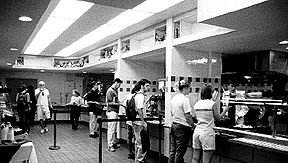

Perhaps Dascomb should be renamed something more apt like McDascomb.

The newly designed food court, which replaced Dascomb's traditional dining hall, was part a major overhaul of dining planned throughout last year. The changes came to fruition this week, and students had mixed reactions.
"Dascomb is really nice, the food is better and there is more space," said junior Keymasha Hall. Other students were not as impressed. College senior Stacey Carter said, "The food is still bland. It looks a lot like Dascomb used to look."
First-year Ryan Miller said, "It is not food I'd like to consume for the rest of my life, but it is better than my preconception of dorm food."
In addition to Dascomb, DeCafˇ, the new snack bar, provides a wide range of products which can be bought with Flex dollars, Obie dollars or cash.
Flex dollars are part of the multiple meal plan, with set amounts added onto students' cards each month. Obie dollars can be added onto a separate account by students or parents. Obie dollars will soon have others uses on campus, such as in copy machines.
A major concern of many students was the amount of waste generated in Dascomb dining hall. Plastic dishes and paper cups were piling up the first week, as was discontent among the students.
Fortunately, the situation is due primarily to the confusion of the first week. Certain improvements, such as plastic glasses, will be available as soon as next week. "Not only can you use them, we beg you," said Assistant Director of Residential Life and Michelle Gross.
Under the new system, students have three choices of how to eat at Dascomb. The first is to eat on non-disposable dishes. If students want to carry out, they have two options. Students will have the option of using their own mugs and reusable containers. If they choose to do so, five cents are taken off the price of each entree and drink when Flex dollars are used.
Reusable containers can be bought at DeCafˇ market for less than four dollars, and dirty containers can be exchanged for clean ones inside Dascomb after each meal.
If students don't choose to use reusable dishes and their own mugs, most other containers are recyclable, and Campus Dining is looking into purchasing utensils made from biodegradable materials. Those items which cannot be recycled, such as napkins, are all made of 100 percent recycled products.
"We hope to educate everyone, even those who might not think about it, what is the most environmentally sensitive way to eat," said Gross.
Despite concerns about waste in Dascomb, the first week has gone relatively smoothly. Employees at the new dining hall like the new system. Heather Houston, Dascomb assistant manager, said, "It's been a little confusing, but that's understandable."
Joyce Edwards, a cafeteria worker, said "So far, so good. The students like it; they're crazy about it." Student response to DeCafˇ has been generally positive. Hall said, "It's nice, but the prices are high. I haven't had a chance to really see how it works."
Many students are particularly happy that they can use their Flex and Obie dollars to buy a variety of products.
"I talked to someone who said it was a good idea to be able to buy other products," college junior Ming Goh said.
But Goh herself preferred the convenience of the old Wilder snack bar. "There are not as many hot options. I like the old snack bar better," she said.
Student co-op members also like the new Wilder market. College junior Nathaniel Stankard said, "Eating in a co-op, I like having a convenience store on campus. It's convenient for me."
Much of last year was spent planning changes to Oberlin's meal plan in response to student demand for more choices and greater flexibility. Student Senate and Campus Dining Services distributed surveys and held two open forums to determine students' needs and desires. The decision to create more flexible meal options led to the need for new facilities. Gross said, "The renovations were done as a result of the new multiple meal plan."
Approximately $600,000 in renovations were made to dining areas in Dascomb Hall and Wilder Hall. Dascomb underwent greater changes compared to Decafˇ. Gross said, "Dascomb is basically the new snack bar, but with five options of entrees."
The food area has been redesigned as a food court, with five stations: LaVincinta, Charleston Market, Firehouse Grill, Salad Bar and Chef's Feature. Mark Sustarsic, Dascomb manager, said, "The concept is to bring Wilder's "grab and go" into a larger area."
At Dascomb, students can either use their meal cards or use Flex and Obie dollars to buy specific food items.
McDascomb: Dascomb's redesign was one change made by the College to dining services over the summer. DeCafe also opened in the old Snack Bar. (photo by Beckey Johns)
Copyright © 1998, The Oberlin Review.
Volume 127, Number 1, September 4, 1998
Contact us with your comments and suggestions.